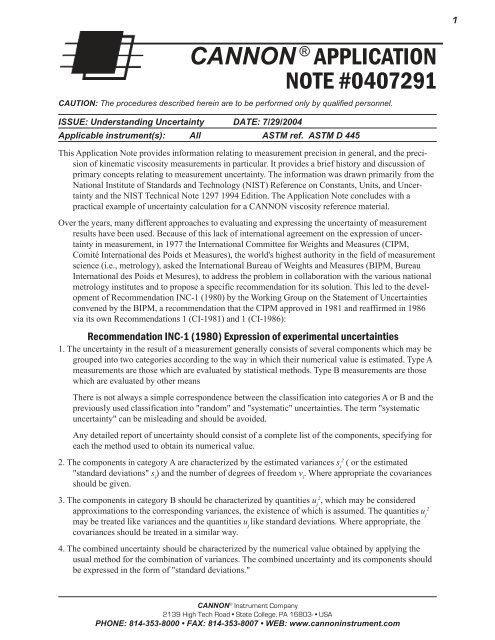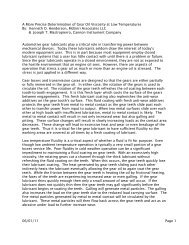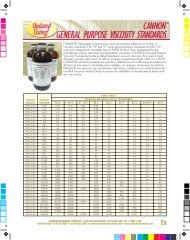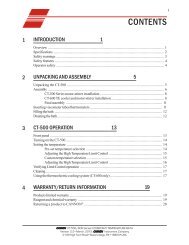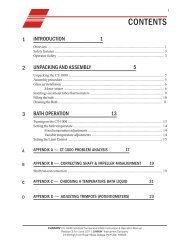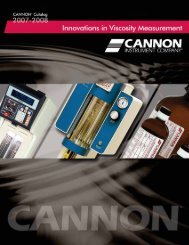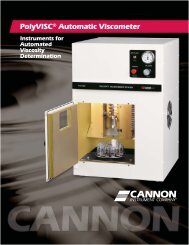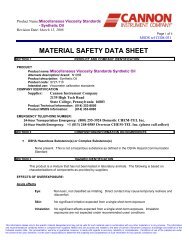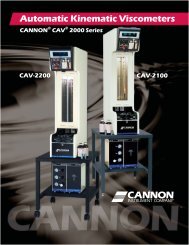significance of expanded uncertainty - Cannon Instrument Company
significance of expanded uncertainty - Cannon Instrument Company
significance of expanded uncertainty - Cannon Instrument Company
You also want an ePaper? Increase the reach of your titles
YUMPU automatically turns print PDFs into web optimized ePapers that Google loves.
1<br />
CANNON ® APPLICATION<br />
NOTE #0407291<br />
CAUTION: The procedures described herein are to be performed only by qualified personnel.<br />
ISSUE: Understanding Uncertainty DATE: 7/29/2004<br />
Applicable instrument(s): All ASTM ref. ASTM D 445<br />
This Application Note provides information relating to measurement precision in general, and the precision<br />
<strong>of</strong> kinematic viscosity measurements in particular. It provides a brief history and discussion <strong>of</strong><br />
primary concepts relating to measurement <strong>uncertainty</strong>. The information was drawn primarily from the<br />
National Institute <strong>of</strong> Standards and Technology (NIST) Reference on Constants, Units, and Uncertainty<br />
and the NIST Technical Note 1297 1994 Edition. The Application Note concludes with a<br />
practical example <strong>of</strong> <strong>uncertainty</strong> calculation for a CANNON viscosity reference material.<br />
Over the years, many different approaches to evaluating and expressing the <strong>uncertainty</strong> <strong>of</strong> measurement<br />
results have been used. Because <strong>of</strong> this lack <strong>of</strong> international agreement on the expression <strong>of</strong> <strong>uncertainty</strong><br />
in measurement, in 1977 the International Committee for Weights and Measures (CIPM,<br />
Comité International des Poids et Measures), the world's highest authority in the field <strong>of</strong> measurement<br />
science (i.e., metrology), asked the International Bureau <strong>of</strong> Weights and Measures (BIPM, Bureau<br />
International des Poids et Mesures), to address the problem in collaboration with the various national<br />
metrology institutes and to propose a specific recommendation for its solution. This led to the development<br />
<strong>of</strong> Recommendation INC-1 (1980) by the Working Group on the Statement <strong>of</strong> Uncertainties<br />
convened by the BIPM, a recommendation that the CIPM approved in 1981 and reaffirmed in 1986<br />
via its own Recommendations 1 (CI-1981) and 1 (CI-1986):<br />
Recommendation INC-1 (1980) Expression <strong>of</strong> experimental uncertainties<br />
1. The <strong>uncertainty</strong> in the result <strong>of</strong> a measurement generally consists <strong>of</strong> several components which may be<br />
grouped into two categories according to the way in which their numerical value is estimated. Type A<br />
measurements are those which are evaluated by statistical methods. Type B measurements are those<br />
which are evaluated by other means<br />
There is not always a simple correspondence between the classification into categories A or B and the<br />
previously used classification into "random" and "systematic" uncertainties. The term "systematic<br />
<strong>uncertainty</strong>" can be misleading and should be avoided.<br />
Any detailed report <strong>of</strong> <strong>uncertainty</strong> should consist <strong>of</strong> a complete list <strong>of</strong> the components, specifying for<br />
each the method used to obtain its numerical value.<br />
2. The components in category A are characterized by the estimated variances s i<br />
2<br />
( or the estimated<br />
"standard deviations" s i<br />
) and the number <strong>of</strong> degrees <strong>of</strong> freedom v i<br />
. Where appropriate the covariances<br />
should be given.<br />
3. The components in category B should be characterized by quantities u j2<br />
, which may be considered<br />
approximations to the corresponding variances, the existence <strong>of</strong> which is assumed. The quantities u j<br />
2<br />
may be treated like variances and the quantities u j<br />
like standard deviations. Where appropriate, the<br />
covariances should be treated in a similar way.<br />
4. The combined <strong>uncertainty</strong> should be characterized by the numerical value obtained by applying the<br />
usual method for the combination <strong>of</strong> variances. The combined <strong>uncertainty</strong> and its components should<br />
be expressed in the form <strong>of</strong> "standard deviations."<br />
CANNON ® <strong>Instrument</strong> <strong>Company</strong><br />
2139 High Tech Road • State College, PA 16803- • USA<br />
PHONE: 814-353-8000 • FAX: 814-353-8007 • WEB: www.cannoninstrument.com
2<br />
5. If for particular applications, it is necessary to multiply the combined <strong>uncertainty</strong> by an overall <strong>uncertainty</strong>,<br />
the multiplying factor must always be stated.<br />
The Guide to the Expression <strong>of</strong> Uncertainty in Measurement (GUM)<br />
The above recommendation, INC-1 (1980), is a brief outline rather than a detailed prescription. Consequently,<br />
the CIPM asked the International Organization for Standardization (ISO) to develop a<br />
detailed guide based on the recommendation because ISO could more easily reflect the requirements<br />
stemming from the broad interests <strong>of</strong> industry and commerce. The ISO Technical Advisory Group on<br />
Metrology (TAG 4) was given this responsibility. It in turn established Working group 3 and assigned<br />
it to develop a guidance document based upon the recommendation <strong>of</strong> the BIPM Working Group on<br />
the Statement <strong>of</strong> Uncertainties which provides rules on the expression <strong>of</strong> measurement <strong>uncertainty</strong> for<br />
use within standardization, calibration, laboratory accreditation, and metrology services;<br />
The end result <strong>of</strong> the work <strong>of</strong> ISO/TAG 4/WG 3 was the 100-page Guide to the Expression <strong>of</strong> Uncertainty<br />
in Measurement (or GUM as it is now <strong>of</strong>ten called). It was published in 1993 (corrected and<br />
reprinted in 1995) by ISO in the name <strong>of</strong> the seven international organizations that supported its<br />
development in ISO/TAG 4:<br />
BIPM<br />
IEC<br />
IFCC<br />
ISO<br />
IUPAC<br />
IUPAP<br />
OIML<br />
Bureau International des Poids et Mesures<br />
International Electrotechnical Commission<br />
International Federation <strong>of</strong> Clinical Chemistry<br />
International Organization for Standardization<br />
International Union <strong>of</strong> Pure and Applied Chemistry<br />
International Union <strong>of</strong> Pure and Applied Physics<br />
International Organization <strong>of</strong> Legal Metrology<br />
GUM Acceptance<br />
GUM methods have been adopted by various regional metrology and related organizations including:<br />
NORAMET<br />
North American Collaboration in Measurement Standards<br />
NAVLAP<br />
National Voluntary Laboratory Accreditation Program<br />
A2LA<br />
American Association for Laboratory Accreditation<br />
EUROMET<br />
European Collaboration in Measurement Standards<br />
EUROLAB<br />
A focus for analytic chemistry in Europe<br />
EA<br />
European Cooperation for Accreditation<br />
EU European Union; adopted by CEN and published as EN 13005.<br />
The GUM has been adopted by NIST and most <strong>of</strong> NIST's sister national metrology institutes throughout<br />
the world, such as the National Research Council (NRC) in Canada, the National Physical Laboratory<br />
(NPL) in the United Kingdom, and the Physikalisch-Technische Bundesanstalt in Germany.<br />
The GUM is the standard reference used by CANNON <strong>Instrument</strong> <strong>Company</strong> in the determination <strong>of</strong><br />
uncertainties associated with our equipment and calibration procedures.<br />
Determination <strong>of</strong> Uncertainties<br />
Type A Uncertainty (variance that is capable <strong>of</strong> measurement by statistical means) determination may be<br />
made by any valid statistical method for treating data. Examples are calculating the standard deviation<br />
<strong>of</strong> the mean <strong>of</strong> a series <strong>of</strong> independent observations using the method <strong>of</strong> least squares to fit a curve to<br />
data in order to estimate the parameters <strong>of</strong> the curve and their standard deviations; and carrying out an<br />
analysis <strong>of</strong> variance (ANOVA) in order to identify and quantify random effects in certain kinds <strong>of</strong><br />
measurements.<br />
Type B Uncertainty (variance that is determined by other means) may include use <strong>of</strong> previous measurement<br />
data, general knowledge <strong>of</strong> relevant materials or instruments, manufacturer's specifications, and<br />
data provided in calibration and other reports.<br />
CANNON ® <strong>Instrument</strong> <strong>Company</strong><br />
2139 High Tech Road • State College, PA 16803- • USA<br />
PHONE: 814-353-8000 • FAX: 814-353-8007 • WEB: www.cannoninstrument.com
3<br />
Combination <strong>of</strong> Uncertainties<br />
Most measurements involve several different actions, all <strong>of</strong> which may introduce an element <strong>of</strong> <strong>uncertainty</strong><br />
into the final measurement. The combined standard <strong>uncertainty</strong> (u c<br />
) is taken to represent the<br />
estimated standard deviation <strong>of</strong> the result. It is obtained by combining the individual standard uncertainties,<br />
using the usual method for combining standard deviations. This method is <strong>of</strong>ten called the<br />
law <strong>of</strong> propagation <strong>of</strong> <strong>uncertainty</strong> and in common parlance as the "root-sum-<strong>of</strong>-squares" (square root<br />
<strong>of</strong> the sum-<strong>of</strong>-the-squares) or "RSS" method <strong>of</strong> combining <strong>uncertainty</strong> components estimated as<br />
standard deviations.<br />
It is assumed that a correction factor is applied to compensate for each recognized systematic effect that<br />
significantly influences the measurement result and that every effort has been made to identify such<br />
effects. The relevant <strong>uncertainty</strong> to associate with each recognized systematic effect is then the<br />
standard <strong>uncertainty</strong> <strong>of</strong> the applied correction. The correction may be either positive, negative, or<br />
zero, and its standard <strong>uncertainty</strong> may in some cases be obtained from a Type A evaluation while in<br />
other cases by a Type B evaluation.<br />
Expanded Uncertainty<br />
Although the combined standard <strong>uncertainty</strong> is used to express the <strong>uncertainty</strong> <strong>of</strong> many measurements,<br />
some commercial, industrial and regulatory applications may require a measure <strong>of</strong> <strong>uncertainty</strong> that<br />
defines an interval about which the measurement value will lie with a certain level <strong>of</strong> statistical<br />
certainty. This type <strong>of</strong> measure is termed <strong>expanded</strong> <strong>uncertainty</strong>, and is determined by multiplying the<br />
combined standard <strong>uncertainty</strong> by a coverage factor, k. The coverage factor is usually in the range <strong>of</strong> 2<br />
to 3. In keeping with practices adopted by a variety <strong>of</strong> national standard laboratories and several<br />
metrological organizations, the stated National Institute <strong>of</strong> Standards and Technology (NIST) policy is<br />
to use <strong>expanded</strong> <strong>uncertainty</strong> U to report the results <strong>of</strong> all NIST measurements other than those for<br />
which combined standard <strong>uncertainty</strong> has traditionally been employed. To be consistent with current<br />
international practice, the value <strong>of</strong> k to be used at NIST for calculating U is, by convention, k = 2.<br />
Values <strong>of</strong> k other than 2 are only to be used for specific applications dictate by established and documented<br />
requirements. When the normal distribution applies and U C<br />
(the combined standard <strong>uncertainty</strong>)<br />
has negligible <strong>uncertainty</strong>, U = 2U C<br />
(coverage factor <strong>of</strong> 2) defines an interval having a level <strong>of</strong><br />
confidence <strong>of</strong> approximately 95 percent. U = 3U C<br />
defines an interval having a level <strong>of</strong> confidence <strong>of</strong><br />
greater than 99 percent.<br />
Harmonizing NIST and ASTM terminology on <strong>uncertainty</strong><br />
One difficulty in understanding and determining <strong>uncertainty</strong> is a lack <strong>of</strong> standardization <strong>of</strong> language used<br />
in discussion <strong>of</strong> <strong>uncertainty</strong>. As previously stated, CANNON reports the <strong>uncertainty</strong> according to the<br />
NIST Technical Note 1297 Guidelines for Evaluating and Expressing the Uncertainty <strong>of</strong> NIST<br />
Measurement Results. However, our customers may also frequently reference ASTM publications, as<br />
we do at CANNON. It is important to understand the relationship <strong>of</strong> the terminology on <strong>uncertainty</strong>.<br />
The following table may be useful:<br />
NIST<br />
Terminology<br />
ASTM Equivalent Terminolog y<br />
Combined<br />
standard <strong>uncertainty</strong> ( U C<br />
) Standard error (SE)<br />
Coverage<br />
factor ( k) Coverage<br />
factor ( k)<br />
Expanded<br />
<strong>uncertainty</strong> ( U ) Combined Extended Uncertainty (CEU)<br />
U = k * U C<br />
CEU<br />
= k * SE<br />
CANNON publishes the <strong>expanded</strong> <strong>uncertainty</strong> with a k = 2 coverage factor.<br />
CANNON ® <strong>Instrument</strong> <strong>Company</strong><br />
2139 High Tech Road • State College, PA 16803- • USA<br />
PHONE: 814-353-8000 • FAX: 814-353-8007 • WEB: www.cannoninstrument.com
4<br />
A practical example <strong>of</strong> <strong>uncertainty</strong> calculation<br />
ASTM D 445-03, the current method for determination <strong>of</strong> kinematic viscosity using glass capillary<br />
viscometers, specifies an acceptable tolerance band (zone) for the acceptability <strong>of</strong> kinematic viscosity<br />
test results. The procedure for ascertaining the tolerance zone (TZ) is described in Annex A4, summarized<br />
as follows:<br />
1) Determine the standard deviation for site <strong>uncertainty</strong> (<br />
2<br />
σ site<br />
). If unknown, use the value 0.19 percent.<br />
2) Determine the combined extended <strong>uncertainty</strong> (CEU) <strong>of</strong> the accepted reference value (ARV) <strong>of</strong> the<br />
certified viscosity calibration standard.<br />
3) Calculate the standard error <strong>of</strong> the accepted calibration, using the following equation:<br />
ΤZ<br />
2<br />
= ±1 .44 σ + SE<br />
site<br />
2<br />
ARV<br />
In the example certificate, assuming a test temperature <strong>of</strong> 25°C and the recommended value for site<br />
<strong>uncertainty</strong>, substituting 0.19 for the site <strong>uncertainty</strong> variable and substituting the appropriate value<br />
from the Certificate <strong>of</strong> Calibration for the standard (see next pages), divided by 2 to account for the<br />
coverage factor, yields the following result, expressed as a percentage:<br />
0.22<br />
2<br />
2<br />
2<br />
ΤΖ = ±1 .44 0.19 + ( ) or<br />
or<br />
In this example, the tolerance zone will be ±0.32 percent <strong>of</strong> the certified viscosity value on the certificate/<br />
bottle label. With the certified value <strong>of</strong> 33.98 centistokes, TZ = 33.871 - 34.089 cSt with 95 percent<br />
certainty. Viscosity measurements made with that standard at that site should fall within that tolerance<br />
zone 19 out <strong>of</strong> 20 times.<br />
CANNON ® <strong>Instrument</strong> <strong>Company</strong><br />
2139 High Tech Road • State College, PA 16803- • USA<br />
PHONE: 814-353-8000 • FAX: 814-353-8007 • WEB: www.cannoninstrument.com
A2LA Certificate #1262.01 1<br />
REPORT OF CALIBRATION<br />
Mfg. Date: 2/25/2004<br />
CANNON ® CERTIFIED VISCOSITY STANDARD<br />
Viscosity Lot Use<br />
Standard: S20 No.: 04101 before: 2/28/2006<br />
Temperature<br />
Kinematic<br />
Viscosity Viscosity Density<br />
Saybolt<br />
Viscosity<br />
°C °F mm 2 /s, (cSt) mPa ⋅s, (cP) g/mL seconds<br />
20.00<br />
25.00<br />
37.78<br />
40.00<br />
50.00<br />
98.89<br />
100.00<br />
68.00<br />
77.00<br />
100.00<br />
104.00<br />
122.00<br />
210.00<br />
212.00<br />
43.49<br />
33.98<br />
19.65<br />
18.02<br />
12.63<br />
3.797<br />
3.720<br />
37.53<br />
29.22<br />
16.73<br />
15.32<br />
10.66<br />
3.084<br />
3.020<br />
0.8630<br />
0.8598<br />
0.8516<br />
0.8501<br />
0.8437<br />
0.8124<br />
0.8117<br />
96.3 SUS<br />
All data are traceable to the National Institute for Standards and Technology<br />
This report <strong>of</strong> calibration shall not be reproduced except in full, without the written approval <strong>of</strong> <strong>Cannon</strong> <strong>Instrument</strong> <strong>Company</strong>.<br />
The <strong>Cannon</strong> <strong>Instrument</strong> <strong>Company</strong> certifies that the kinematic viscosities were determined by the Master Viscometer technique reported in<br />
the Journal <strong>of</strong> Research <strong>of</strong> the National Bureau <strong>of</strong> Standards, (Vol. 52, No. 3, March 1954, Research Paper 2479) and <strong>Cannon</strong> Laboratory<br />
Standard viscometer. The above data are based on the primary standard, water at 20°C (ITS-90), with a viscosity <strong>of</strong> 1.0016 mPa ⋅s or<br />
kinematic viscosity <strong>of</strong> 1.0034 mm 2 /s as listed in ISO 3666. See also ASTM methods D2162, D445, D446, D2161, D2171 and ISO 3104<br />
and 3105. This material ceases to be a standard after the date shown on this certificate. Manufactured in the U.S.A.<br />
FILE COPY<br />
R. E. Manning, Ph.D., P.E.<br />
M. T. Zubler<br />
K. O. Henderson<br />
Results relate only to the sample tested.<br />
1 The inclusion <strong>of</strong> the A2LA logo does not imply certification/approval <strong>of</strong> the products calibrated or tested<br />
Page 1 <strong>of</strong> 2<br />
P10.0207 ©2004 0304
ANALYSIS OF DATA<br />
1262.01 1<br />
Kinematic viscosity measurements at temperatures <strong>of</strong> 20°C through 40°C have been made using<br />
<strong>Cannon</strong> and <strong>Cannon</strong>-Ubbelohde (long-capillary) Master viscometers, as described in ASTM<br />
D 2162. Measurements at lower and higher temperatures have been made using <strong>Cannon</strong>-Ubbelohde<br />
Laboratory Standard viscometers. The <strong>expanded</strong> <strong>uncertainty</strong> <strong>of</strong> the measurements at 95% K=2<br />
confidence over the temperature range <strong>of</strong> -40°C to +150°C is as follows:<br />
Range <strong>of</strong> Kin Vis<br />
Expanded Uncertainty* (%) at temperatures:<br />
(mm 2 /s) 45°C<br />


